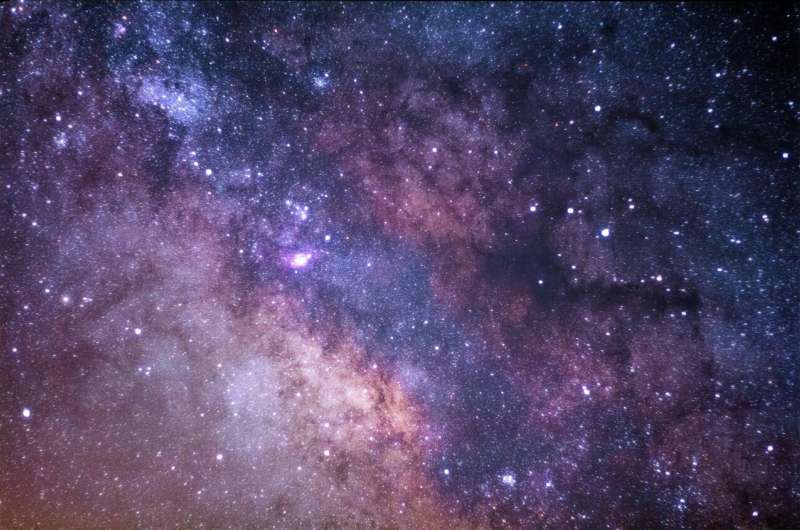February 29, 2024 feature
This article has been reviewed according to Science X's editorial process and policies. Editors have highlighted the following attributes while ensuring the content's credibility:
fact-checked
peer-reviewed publication
trusted source
proofread
How 'the strong force' influences the gravitational wave background

Gravitationally speaking, the universe is a noisy place. A hodgepodge of gravitational waves from unknown sources streams unpredictably around space, including possibly from the early universe.
Scientists have been looking for signs of these early cosmological gravitational waves, and a team of physicists have now shown that such waves should have a distinct signature due to the behavior of quarks and gluons as the universe cools. Such a finding would have a decisive impact on which models best describe the universe almost immediately after the Big Bang. The study is published in the journal Physical Review Letters.
Scientists first found direct evidence for gravitational waves in 2015 at the LIGO gravitational wave interferometers in the US. These are singular (albeit tiny amplitude) waves from a particular source, such as the merger of two black holes, which wash past Earth. Such waves cause the 4-km perpendicular arms of the interferometers to change length by miniscule (but different) amounts, the difference detected by changes in the resulting interference pattern as laser beams travel back and forth in the detector's arms.
But there are smaller gravitational waves as well, so many that they look like noise. Scientists have been diligently looking amidst this noise for the stochastic gravitational wave background (stochastic means randomly determined, viz. unpredictable). But these smaller gravitational waves are more difficult to detect, and scientists have turned to millisecond pulsar arrays, in which the distance from Earth to a distant pulsar is the effective interferometer arm length.
Pulsars—rotating neutron stars—send out beams of radiation, a few in a direction such that the beam sweeps past Earth, like a beam from a rotating lighthouse. Pulsars have an extremely stable period of revolution, and any measurement of this clock timing would be subtly altered by the passing myriad smaller gravitational waves that have wavelengths of light years.
Last year the NANOgrav collaboration published evidence that these low frequency, stochastic gravitational waves do exist in the spacetime background, as did other groups. But what is their source? Does the backdrop originate from astrophysical phenomena, such as hundreds of thousands of merging supermassive black holes, supernovae, and the like?
Perhaps the background originated in the early universe and its waves have been propagating every since, akin to the cosmic microwave background that fills all of space due to the decoupling of photons from electrons 380,000 years after the Big Bang. Or something else?
Distinguishing the scenarios faces challenges. The current understanding of the physics of supermassive black holes is not yet sufficiently developed enough to draw firm conclusions. And the continuous spectrum of background gravitational waves depends on the microscopic details of their source and requires detailed numerical simulations.
This new work provides a way to distinguish early universe waves from those from other sources. Standard model physics—the successful theories of the strong, weak and electromagnetic interactions—should leave a distinct footprint on the background measured which is independent of the exact early universe model chosen.
As the universe cooled from the initial moment of the Big Bang, it went through various phases. One mentioned above is the decoupling of photons after 380,000 years, as the universe became cool enough so that electrons could bond to protons and form hydrogen atoms, leaving the photons suddenly adrift.
But there was an earlier transition, or crossover, as free quarks and gluons, which had formed a quark-gluon plasma, coalesced into individual particles of two or more quarks stuck together as a result of the strong force, with gluons trapped with them.
This "quantum chromodynamics (QCD) crossover" is expected to have happened when the universe had a temperature of about one trillion Kelvin, about 10-5 seconds after the Big Bang. That corresponds to an energy of about 100 MeV. (QCD is the theory of the strong force.)
As it turns out, the nanohertz frequencies being probed by pulsar timing arrays are of the same order as the observable low-frequency stochastic gravitational waves in the background. The crossover does not create the waves, but the sudden drop in free particle number changes the equation that governs the state of the universe. Gravitation wave sources before the QCD crossover produce a low-frequence signal that are affected by this change in equation of state. Researchers say that signal can now be searched for in the pulsar timing array data.
"We think that an accurate characterization of the gravitational wave background for different origins is a crucial step to move forward in this exploration," said Davide Racco, a co-author on the paper from Stanford University's Institute for Theoretical Physics.
"We highlight a generic and unavoidable feature for a wide range of primordial phenomena that we prove to be a useful ingredient to discriminate between different sources of the background."
Such a result would be a startling impact of the intricacies of quantum physics on the universe we see today, demonstrating again how particle physics and cosmology meet on the same ground.
More information: Gabriele Franciolini et al, Footprints of the QCD Crossover on Cosmological Gravitational Waves at Pulsar Timing Arrays, Physical Review Letters (2024). DOI: 10.1103/PhysRevLett.132.081001
Journal information: Physical Review Letters
© 2024 Science X Network




















